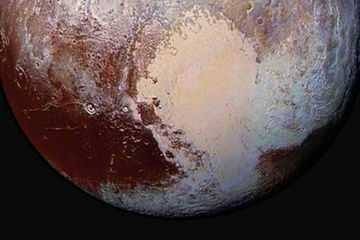Scientists Deeply Look What is Inside the Wandering Heart of the Planet Pluto and See How Cold It is
| Theena Ocay | | Nov 17, 2016 08:27 PM EST |
(Photo : Facebook) As published on Wednesday in the two papers of journal Nature, researchers say Sputnik Planatia, which is the left lobe of Pluto's famous "heart," is on the move that it slowly drifting toward the equator of planet Pluto.
Scientists deeply look what is inside the wandering heart of the planet Pluto and found out more evidence that help them to conclude that the planet could be hiding an ocean of water beneath its icy surface.
As published on Wednesday in the two papers of journal Nature, researchers say Sputnik Planatia is on the move that it slowly drifting toward the equator of planet Pluto.
Like Us on Facebook
Sputnik Planatia, which is the left lobe of Pluto's famous "heart," is a 600-mile-wide (1,000 kilometers) and formerly known as Sputnik Planum.
Sputnik Planatia is align nicely with the Pluto-Charon tidal axis, the line along which the gravitational pull from the Pluto's largest moon, Charon, is the strongest.
Journal Nature reported that the location of Sputnik Planitia is the natural consequence of the sequestration of volatile ices within the basin and the resulting reorientation (true polar wander) of Pluto.
These volatile ices loading in the left lobe of pluto's heart can substantially alter Pluto's inertia tensor, resulting in a reorientation of the planet Pluto of around 60 degrees with respect to the rotational and tidal axes.
Result of the Combination of This Reorientation
A global network of extensional faults that closely replicate the observed fault networks on Pluto was resulted from the combination of the loading and global expansion due to the freezing of a possible subsurface ocean generates stresses within the Pluto's lithosphere.
The volatile transport cycles on Pluto may result on probable northwest formation of Sputnik Planitia. Pluto's heart was loaded with volatiles over million-year timescales.
Pluto's past, present, and future orientation is controlled by feedbacks between volatile sublimation and condensation, changing insolation conditions and Pluto's interior structure.
What Scientists Suggested on the Two Papers?
James Keane, a graduate student at the University of Arizona who is the first author of one of the papers, explained that the phenomenon responsible for making Pluto's heart move has been observed on other terrestrial bodies like the moon, Mars, Venus, Mercury, and even our own planet Earth. Scientists call it "true polar wander."
Francis Nimmo, planetary scientist at UC Santa Cruz who is the author of the other paper, comes to a slightly different conclusion, saying that the positive mass anomaly was probably caused by a subsurface ocean that moved closer to the surface in the area of the impact crater.
It is hard to imagine Pluto reorienting in this way if it did not have an ocean, Nimmo said.
Tagsplanet, Pluto, Heart, Scientists, Sputnik Planatia
©2015 Chinatopix All rights reserved. Do not reproduce without permission
EDITOR'S PICKS
-

Did the Trump administration just announce plans for a trade war with ‘hostile’ China and Russia?
-

US Senate passes Taiwan travel bill slammed by China
-

As Yan Sihong’s family grieves, here are other Chinese students who went missing abroad. Some have never been found
-

Beijing blasts Western critics who ‘smear China’ with the term sharp power
-

China Envoy Seeks to Defuse Tensions With U.S. as a Trade War Brews
-

Singapore's Deputy PM Provides Bitcoin Vote of Confidence Amid China's Blanket Bans
-

China warns investors over risks in overseas virtual currency trading
-

Chinese government most trustworthy: survey
-

Kashima Antlers On Course For Back-To-Back Titles
MOST POPULAR
LATEST NEWS
Zhou Yongkang: China's Former Security Chief Sentenced to Life in Prison

China's former Chief of the Ministry of Public Security, Zhou Yongkang, has been given a life sentence after he was found guilty of abusing his office, bribery and deliberately ... Full Article
TRENDING STORY

China Pork Prices Expected to Stabilize As The Supplies Recover

Elephone P9000 Smartphone is now on Sale on Amazon India

There's a Big Chance Cliffhangers Won't Still Be Resolved When Grey's Anatomy Season 13 Returns

Supreme Court Ruled on Samsung vs Apple Dispute for Patent Infringement

Microsoft Surface Pro 5 Rumors and Release Date: What is the Latest?













